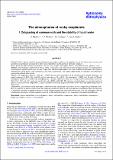Files in this item
The atmospheres of rocky exoplanets : I. Outgassing of common rock and the stability of liquid water
Item metadata
| dc.contributor.author | Herbort, Oliver | |
| dc.contributor.author | Woitke, Peter | |
| dc.contributor.author | Helling, Christiane | |
| dc.contributor.author | Zerkle, Aubrey | |
| dc.date.accessioned | 2020-05-11T15:30:07Z | |
| dc.date.available | 2020-05-11T15:30:07Z | |
| dc.date.issued | 2020-04 | |
| dc.identifier | 267586157 | |
| dc.identifier | 613cad49-3e5d-462f-9de5-977179b98fdc | |
| dc.identifier | 85083827514 | |
| dc.identifier | 000530110700001 | |
| dc.identifier.citation | Herbort , O , Woitke , P , Helling , C & Zerkle , A 2020 , ' The atmospheres of rocky exoplanets : I. Outgassing of common rock and the stability of liquid water ' , Astronomy & Astrophysics , vol. 636 , A71 . https://doi.org/10.1051/0004-6361/201936614 | en |
| dc.identifier.issn | 0004-6361 | |
| dc.identifier.other | ArXiv: http://arxiv.org/abs/2003.03628v1 | |
| dc.identifier.other | ORCID: /0000-0003-2324-1619/work/72842894 | |
| dc.identifier.other | ORCID: /0000-0002-1807-4441/work/75610525 | |
| dc.identifier.uri | https://hdl.handle.net/10023/19918 | |
| dc.description | Funding: O.H. acknowledges the PhD stipend from the University of St Andrews’ Centre for Exoplanet Science. | en |
| dc.description.abstract | Context. Little is known about the interaction between atmospheres and crusts of exoplanets so far, but future space missions and ground-based instruments are expected to detect molecular features in the spectra of hot rocky exoplanets. Aims. We aim to understand the composition of the gas in an exoplanet atmosphere which is in equilibrium with a planetary crust. Methods. The molecular composition of the gas above a surface made of a mixture of solid and liquid materials was determined by assuming phase equilibrium for given pressure, temperature, and element abundances. We study total element abundances that represent different parts of the Earth’s crust (continental crust, bulk silicate Earth, mid oceanic ridge basalt), CI chondrites and abundances measured in polluted white dwarfs. Results. For temperatures between ~600 and ~3500 K, the near-crust atmospheres of all considered total element abundances are mainly composed of H2O, CO2, and SO2 and in some cases of O2 and H2. For temperatures ≲500 K, only N2-rich or CH4-rich atmospheres remain. For ≳3500 K, the atmospheric gas is mainly composed of atoms (O, Na, Mg, and Fe), metal oxides (SiO, NaO, MgO, CaO, AlO, and FeO), and some metal hydroxides (KOH and NaOH). The inclusion of phyllosilicates as potential condensed species is crucial for lower temperatures, as they can remove water from the gas phase below about 700 K and inhibit the presence of liquid water. Conclusions. Measurements of the atmospheric composition could, in principle, characterise the rock composition of exoplanet crusts. H2O, O2 and CH4 are natural products from the outgassing of different kinds of rocks that had time to equilibrate. These are discussed as biomarkers, but they do emerge naturally as a result of the thermodynamic interaction between the crust and atmosphere. Only the simultaneous detection of all three molecules might be a sufficient biosignature, as it is inconsistent with chemical equilibrium. | |
| dc.format.extent | 18 | |
| dc.format.extent | 3387721 | |
| dc.language.iso | eng | |
| dc.relation.ispartof | Astronomy & Astrophysics | en |
| dc.subject | Planets and satellites: terrestrial planets | en |
| dc.subject | Planets and satellites: composition | en |
| dc.subject | Planets and satellites: atmospheres | en |
| dc.subject | Planets and satellites: surfaces | en |
| dc.subject | Astrochemistry | en |
| dc.subject | QB Astronomy | en |
| dc.subject | QC Physics | en |
| dc.subject | QD Chemistry | en |
| dc.subject | 3rd-DAS | en |
| dc.subject.lcc | QB | en |
| dc.subject.lcc | QC | en |
| dc.subject.lcc | QD | en |
| dc.title | The atmospheres of rocky exoplanets : I. Outgassing of common rock and the stability of liquid water | en |
| dc.type | Journal article | en |
| dc.contributor.institution | University of St Andrews. School of Physics and Astronomy | en |
| dc.contributor.institution | University of St Andrews. St Andrews Centre for Exoplanet Science | en |
| dc.contributor.institution | University of St Andrews. School of Earth & Environmental Sciences | en |
| dc.contributor.institution | University of St Andrews. St Andrews Isotope Geochemistry | en |
| dc.identifier.doi | https://doi.org/10.1051/0004-6361/201936614 | |
| dc.description.status | Peer reviewed | en |
This item appears in the following Collection(s)
Items in the St Andrews Research Repository are protected by copyright, with all rights reserved, unless otherwise indicated.

